Foxton and its locks
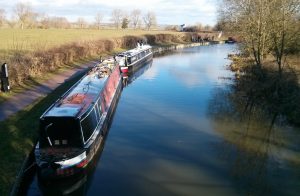
I have dragged many visitors to Foxton Locks since my random move to Northants 20+ years ago. Way before my mad boat buying I would take unsuspecting guests to Foxton, only 20-ish minutes from home. Once there I always seem to have the same routine. Parking in the top car-park, meandering under and then over the turn-around bridge onto the towpath. Then taking the tow path towards the locks. From the top you can look down the hillside, past the 10 locks to the two pubs, café, shop and Bridge 61 at the bottom. In the dark and distant past (probably 20 years ago) I did eat in one of the pubs. It was memorable for the wrong reasons as I was served a mouldy ploughman’s. I love Stilton, but this was cheddar gone bad! (And I don’t mean a lump of cheddar had run amok…)
Since then the pub has changed hands, the towpath has been asphalted, there are sculptures, historical signage and the entire spot has become a gongoozlers delight. So, when I revisited for the first time in four years in February 2018 – no visitors and a stint living abroad meant a 4 year gap – I was attracted by the chance to go down inside a lock. This experience was provided by the Canal and River Trust (CRT) Winter Open Day.
Leicester Line, the Watford Flight and Foxton
Foxton marks one end of a 23 mile lock free* stretch of the Leicester Line of the Grand Union. My boat, Pea Green is moored just off this stretch in Welford. At the other end, to the south, are Watford locks. Watford, Northamptonshire marks the confluence of Watling Street (dating back to the Romans), the West Coast Mainline (some stuck on trains might think they’ve been there since the Romans), the M1 (we all know about the jams on there) and of course the Grand Union Canal. It is a surreal and noisy moment when you find yourself on a boat, on a canal, running parallel to the M1 or the West Coast Mainline, as I did when moving my boat for the first time. I must admit I find this historical layering of road, rail, and canal routes at Watford fascinating. Just think about the people who built each route or those who lived alongside. Each route, during its moment in time, provided new links between one settlement and another and new channels for news to travel down. Each was a ground breaking information highway.
The Foxton Locks
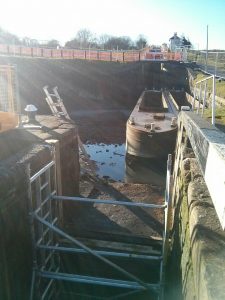
Foxton, at the other end of the 23 mile stretch, is very different but no-less important for its industrial heritage. It does lack the noise of Watford, though in the past, when the inclined plane was in in full pelt it too would have been a noisy industrial spot. The locks are Grade 1 listed, and consist of two staircase flights of 5 narrow locks.Between the two flights is a lock pound allowing for boats to pass. Alongside are the ponds that fill the locks. They are a haven for wildlife – rumour has it a family of otters are in residence. A short distance from the locks are the remnants of the inclined plane. As far as industrial heritage goes this is way up there, and is a Scheduled National Monument. (For the uninitiated this means it holds the same heritage status as the likes of Stonehenge!) More about the inclined plane in future posts. Perhaps the best way to describe it, for those with little engineering knowledge, is as a kind of funicular for narrowboats (sorry engineers, I know this is not an ideal description). When operational narrowboats would have been moved from the canal at the bottom of the hill up to the canal at the top in huge steel water tanks.
CRT open days & lock visits
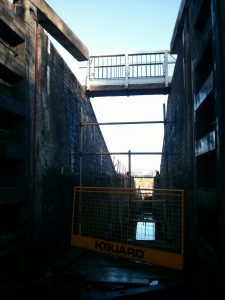
Anyway, back to the locks and my February visit. As regular readers will know I have an innate fear of locks brought on by being a child of the 70s. I must admit going down into an empty lock did little to dispel my fears. However, having never seen any lock drained I decided to visit. CRT winter open days are a relatively new addition to the winter closure schedule. They have taken place at a number of locations throughout the winter. From my limited experience they seem to be popular, and I am sure many visitors sign up to CRT membership during the day. Winter Open Days allow anyone who cares to show-up a unique chance to see industrial heritage and repairs close up. They also provide the opportunity for beleaguered winter boaters who are trying to negotiate, what can be frustrating winter closures, a chance to see the work being done. (Not to mention understand where some of their licence fee is going!)
February 2018
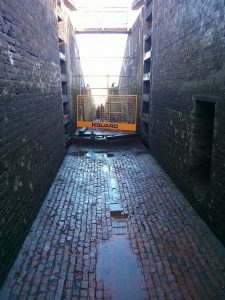
In my OCD-got-to-get-there-early-way I was, of course, parked and heading down to the locks before 9.30am on the Sunday open day. (A friend had told me the car-parks had been full by 11am on the Saturday, and I couldn’t face park and ride!) After the horizontal rain that had featured on Saturday it was a relief to arrive in bright sunshine, albeit bitterly cold. Down the hillside next to the locks the CRT volunteers and staff were battling the wind to set up their shelter tents, and trying to avoid the muddy quagmire of the towpath verges. In my brief engagement with CRT I have always been impressed with the CRT volunteers, whom I have met at various places along the way. Their enthusiasm for the canals and the support they have given me as a single-hander on my boat, has been quite something. In my view they are worth their weight in gold, not least for the PR role they undertake for the charity. Alongside the volunteers there were also a couple of CRT apprentices. They had travelled to Foxton and given up their weekend to talk to the public about the CRT apprenticeship scheme.
A lock of ones own
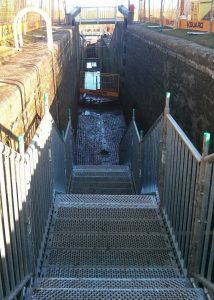
Although the two locks for visitors were not due to open until 10am I was lucky to sneak in before, with the marvellous Graham, who works with CRT apprentices. With his apprentices setting up the stall he kindly offered to accompany me into the lock. Before I visited I had imagined clambering down lock ladders and dangling off ropes to reach the lock bottom. (I have a vivid imagination and have travelled too much in developing world countries where this would have happened!) Whereas actually a fully functioning wide staircase had been constructed down into the two locks open to the public. (Clearly health and safety wouldn’t have allowed for my Lara-Croft-style lock descent.) It was a peculiar feeling to descend into a lock chamber that is normally full of water, fish, mussels and boats. Even stranger was to stand on the red brick floor of the lock, reminiscent of a red cobbled street, with the tall lock walls and open gates towering above. It reminded me of being in a narrow street looking up at looming skyscrapers. The floor is original, dating back to the early 1800s when the locks were built. It gently slopes upwards on both sides to provide more stability to the walls.
Questions, questions…

What isn’t clear, and neither Graham, nor the volunteer who joined us knew, is where the 100s of bricks were made, nor how they were brought to the site. Also, what isn’t know is who were the men who built the locks? Apparently, recent research has revealed that at Stoke Bruerne a small town developed as Cornish miners and their families travelled to Northants to build the locks and the Blisworth tunnel. But, at Foxton the question still remains of who the men were, where they lived and what happened to them after the locks were complete. I am not an expert of brickwork but Graham also pointed out to me the different types of brick work in the lock walls. In places it is English bond, yet other bits take a different form. In the middle of the lock wall, close to the floor is a hole with a sluice gate leading to the filling ponds. Seeing this did little to dispel my lock fear, with images of people being sucked into the sluice as the paddle-gate is opened. (To be honest it is a wonder that I ever take my boat through any locks!).
I felt very privileged to have had the lock to myself before large amounts of people arrived. It was also impressive to be able to look through the open lock gates and through another open lock. This open gate view gave a real sense of the feat of early 19th Century engineering.
Lock sharing
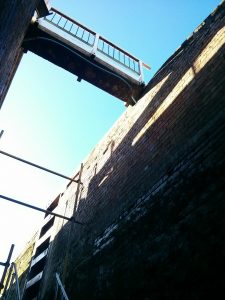
During the open weekend two locks were open to visit, one in the top flight and one in the bottom. After visiting the bottom open lock I also went down into the other lock in the top section of the flight. Though by the time I headed back up the hill the open day was in full swing, with lots of people around. As a result the volunteers were monitoring the numbers of people they were allowing into the locks. Just as my first lock had been special because I was on the only visitor in it, this second descent was fascinating as a way to gauge other peoples’ reactions to being in the bottom of a lock. There was undoubtedly a level of excitement and interest from the people on the lock floor, with families taking group pictures and others marvelling at the brick work. The same can’t be said for the couple of dogs that had made it down the staircase into the lock. They appeared decidedly unnerved by the watery smells and the appearance of some fresh water mussels that lurked in a couple of puddles.
Worth the effort
From my perspective of history geek and boaty person I would recommend a visit to a CRT winter open day. For anyone who has an interest in UK canals and their history, and ongoing engineering this is a great free way to learn more. You will probably only need a few hours to see the work that is being undertaken. You can engage with parts of history that are usually hidden by the murky water of our canals. (And of course you could always then head to the pub for a ploughman’s!)
__________
*this ignores the single lock you have to work to get into Welford. However it is on the Welford Arm and not the main Leicester line, I feel I am not lying.
Great article Kay on the hidden world of locks. I love them. And I also love those bricks, fantastic. And I am glad from your other post to see you weren’t really sinking!!
Thanks Edie, it was the sinking cliff hanger 🙂 it was really fascinating to be stood on the bottom of a lock and wonder about the men who built them :). More soon.kay
Kay, I showed Brian the bricks. Another place he’d like to visit.
The canal and river trust do open weekends each winter when you can go into the bottom of a lock, so they aren’t always local, but worth a journey to see them 🙂